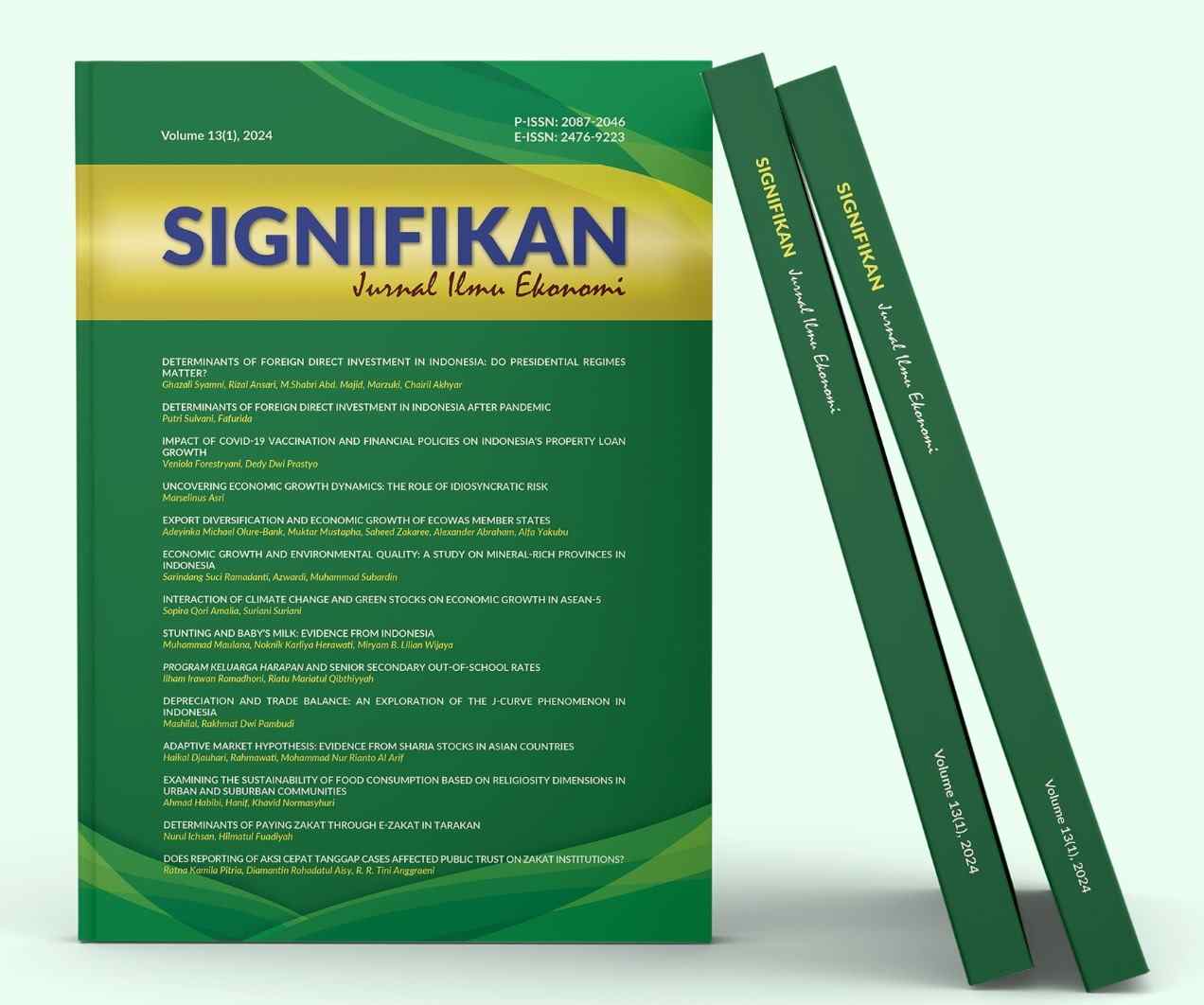Export Diversification and Economic Growth of ECOWAS Member States
DOI:
https://doi.org/10.15408/sjie.v13i1.37999Keywords:
gravity model, economic integration, trade flows, export diversificationAbstract
Research Originality: Using the data of export diversification index which is excluded in previous studies and most the pervious only look at the relationship between ED and GDP, excluding per capita income as basics for development. Again, previous studies results are contradictory on impact of export diversification performance. Additionally, this paper provides robust empirical evidence of a positive effect of export diversification on per capita income growth.
Research Objectives: This paper has the objective to examines how export diversification (ED) increase economic growth and per capita income.
Research Methods: The paper achieve its objectives using, panel least technique and co-integration test are used on time series data of 1984-2022 for ECOWAS states.
Empirical Results: The paper shows that the export diversification index has a significant influence on GDP growth but inverse, however, manufacturing value-added shows weak but a positive influence on the growth per capita income. Again, the paper reveals that high skewness of ECOWAS region to primary products export which could be responsible for the low growth per capita income. The finding of this is not the volume of exported products that matters, but how dynamic is exported products.
Implications: The paper therefore recommends ECOWAS countries need to develop processing capability for export that comes from endogenous sufficiency.
JEL Classification: C23, F10, O47, O55
References
Aditya, A., & Acharyya, R. (2013). Export Diversification, Composition, and Economic Growth: Evidence from Cross-Country Analysis. The Journal of International Trade & Economic Development, 22(7), 959-992. https://doi.org/10.1080/09638199.2011.619009.
Agosin, M. P. (2017). Export Diversification and Growth in Emerging Economics. Working Paper No. 233, Universidad de Chile: Departmento de Economia.
Amaghionyeodiwe, L., Ogundipe, A., & Ojeaga, P. (2014). Transnational Trade in ECOWAS: Does Export Content Matter? International Journal of Business and Social Science, 5(1), 1-12.
Amurgo-Pacheco, A., & Pierola, M. D. (2018). Pattern of Export Diversification in Developing Countries: Intensive and Extensive Margins. Policy Research Working Paper 4473, The World Bank International Trade Department.
Azam, M., & Azam, S. (2023). Export Diversification and Economic Growth in Bangladesh. Journal of Empirical Studies, 10(1), 1-18. https://doi.org/10.18488/66.v10i1.3291.
Balza, L. (2018) Market Diversification and Export Growth in Latin America. Working Paper, Universidad Central de Venezuela.
Bebczuk R. N., & Berrettoni, N. (2016). Explaining Export Diversification: An Empirical Analyses. CAF Research Program on Development Issue, Department of Economics, Universidad Nacional de la plata, Argentina.
Cameron, M., Cuyvers, L. J., Fu, D., & Viviers, W. (2021). Identifying Export Opportunities for China in the ‘Belt and Road Initiative’ Group of Countries: a Decision Support Model Approach. Journal of International Trade Law and Policy, 20(2), 101-126. https://doi.org/10.1108/JITLP-11-2020-0061.
Ferreira, G. (2019). From Coffee Beans to Microchips: Export Diversification and Economic Growth in Costa Rica. Proceeding of the Southern Agricultural Economics Association Annual Meeting, Atlanta, Georgia. Louisiana State University.
Mania, E., & Rieber, A. (2019). Product Diversification and Sustainable Economic Growth in Developing Countries. Structural Change and Economic Dynamics, 51, 138-151. https://doi.org/10.1016/j.strueco.2019.08.006.
Martincus, C. V., & Go’mez, S. M. (2019). Trade Policy and Export Diversification; What Should Colombia Expect from The FTA with The United States. IDB Working Paper Series WP- 136.
Matezo, E., Makengo, B., & Muhole, A. (2021). The Influence of Export Diversification on Economic Growth: A Case of Southern African Development Community (SADC). American Journal of Industrial and Business Management, 11, 829-845. https://doi.org/10.4236.ajibm.2021.117051.
Mora, J., & Olabisi, M. (2023). Economic Development and Export Diversification: The Role of Trade Cost. International Economics, 173, 102-118. https://doi.org/10.1016/j.inteco.2022.11.002.
Odularu, G. O. (2008). Export Diversification as A promotion Strategy for Intra-ECOWAS Trade Expansion. Africa Journal of Business Management, 3(2), 32-38.
Olayiwola, W K., & Ola-David, O. A. (2013). Economic Integration, Trade Facilitation and Agricultural Exports Performance in ECOWAS Member States. Proceedings of the 8th African Economic Conference on Regional Integration in Africa.
Osakwe, P. N., & Kilolo, J-M. (2018). What Drives Export Diversification? New Evidence from a Panel of Developing Countries. UNCTAD Research Paper No. 3.
Sarin, V., Mahapatra, S. K., & Sood, N. (2020). Export Diversification and Economic Growth: A Review and Future Research Agenda. Journal of Public Affairs, 22(3), e2524. https://doi.org/10.1002/pa.2524.
Sim, L., & Karim, A. (2019). Export Diversification and Economic Growth in Malaysia. MPRA Working Paper No. 20588.
Sunaryati. (2015). Export Diversification and Economic Growth in ASEAN. Jurnal Ekonomi dan Studi Pembangunan, 16(2), 119-131.
Trinh, P. T. T., & Thuy, H. T. T. (2021) Export Diversification and Economic Growth: A Threshold Regression Approach for Emerging Markets and Developing Countries. Economic Journal of Emerging Markets, 13(2), 188-199. https://doi.org/10.20885/ejem.vol13.iss2.art8.
Zhou, H., & Nyandoro, J. M. (2023). Export Diversification and Economic Growth: Evidence from Zimbabwe. Botswana Journal of Economics, 15(1), 1-9. https://doi.org/10.5897/BOJE2022.0007.

